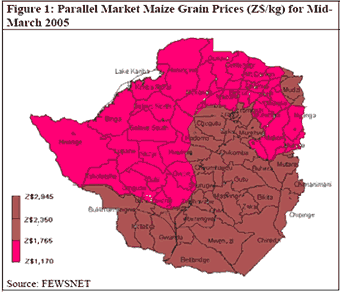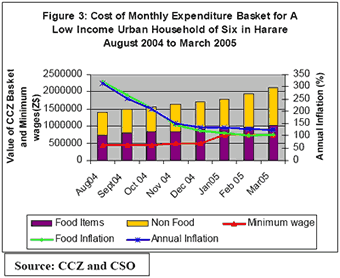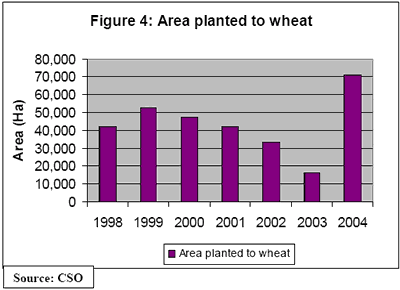| |
Back to Index
Zimbabwe
food security update April 2005
Famine
Early Warning Systems Network (FEWS NET)
May
20, 2005
http://www.fews.net/centers/innerSections.aspx?f=zw&m=1001613&pageID=monthliesDoc
Summary
and implications
The
food security problem facing Zimbabwe is of such a magnitude that
Zimbabwe will need to import substantial amounts of cereals during
the April 2005 - March 2006 consumption year in order to ensure
sufficient food is available for all Zimbabweans. It will be critical
for the government, private sector and the humanitarian community
to create effective partnerships to ensure adequate in-country distribution
of this food. The majority of farming households will harvest nothing
and are already dependent on the market for all their food requirements
at a time when own crop production would normally be their dominant
source of food. Income opportunities in rural Zimbabwe will be more
limited this year than they were last year, making it difficult
for many to compensate for their crop losses through purchases,
even if the food is available on the market.
Seasonal
timeline

Summary
of food security hazards
- Failed crop
production
- Foreign currency
shortages
- Basic commodity
shortages in both rural and urban markets
- Escalating
basic commodity prices
- High staple
food prices
Food
security summary
A
few rural households in parts of the Mashonaland provinces, Manicaland
and Midlands provinces will harvest some food crops from their fields.
For many, the harvested crops will only last for a few months. The
majority of farming households in the southern provinces of the
country will harvest nothing from their fields.
Parallel market
grain prices normally decline rapidly at this time of the year,
in response to improved supply from the harvest. This year, the
expected fall in prices has not occurred, and instead, prices continue
to increase throughout the country. As illustrated in Figure 1,
prices are highest in the central and southern districts where crop
conditions are reported to be worst.

The National
Availability Problem
As
a result of the production failure this year, the bulk of Zimbabwe's
1.8 million MT maize consumption requirement will have to be imported.
While some of this food can be safely distributed through the normal
marketing mechanism, much of it will need to be distributed through
timely food aid programs because of critical household cash income
deficits, discussed below. Importing and distributing this food
will require substantial foreign currency resources, considerable
improvement in the operational efficiency of the Grain Marketing
Board (GMB) and its capacity to move and distribute grain within
the country, and a widening of the range of players in the distribution
of food in the country to include greater private sector participation.
However, Zimbabwe's
foreign currency situation has been deteriorating steadily since
1999, with a deficit of over 600 million USD reached in 2004. (See
Figure 2). Since the beginning of 2005, the foreign currency auction
floor has been supplying far less foreign currency than the amount
required by participants at the auction. The demand for foreign
currency on the auction floor has grown to about US$215 million,
yet the amount of foreign currency made available by the Reserve
Bank of Zimbabwe for allotment remains at just US$11million. The
low average prices for tobacco so far this year and the fall of
world cotton prices from about US$0.75 last year to about US$0.58
this year puts further constraints on the foreign currency reserves.
At the same time, the need for food imports has to compete with
other national priorities such as fuel, electricity, medicines and
education, all of which require foreign currency. Given the current
shortages, importing adequate food for the nation in the current
consumption year is going to be an enormous challenge for Zimbabwe.

Household
Access Problems
In
the 2003/04 consumption year, Zimbabwe produced about 1 million
MT of maize and about 71,000 MT of sorghum. The Zimbabwe Vulnerability
Assessment Committee (ZimVAC) estimated that own crop production
accounted for about 42 percent the total food sources available
to an average rural household in Zimbabwe in that year. Given that
cereal production will be substantially lower in the 2004/05 cropping
season than in 2002/2003, the contribution to average household
food income from own crop production can reasonably be expected
to be much less. The deficit is expected to be even bigger for poor
households and the majority of households in the traditionally grain
deficit areas. Consequently, most rural households in Zimbabwe will
be dependent on grain supplies emanating from outside their local
areas, accessed through the market, remittances, gifts and food
assistance programs.
Poor crop production
will also limit rural incomes. Cotton and tobacco normally provide
important seasonal cash income to smallholder farming households.
However, production of these crops in the smallholder sector is
expected to be down this year. A combination of poor rainfall conditions
and limited credit support to cotton farmers by cotton marketing
companies during the 2004/05 cropping season resulted in a smaller
area planted to cotton as well as a decline in yields. The Zimbabwe
Cotton Producers Association estimates the 2004/05 cotton harvest
to be between 140,000 and 150,000 MT, down from last season's harvest
of about 333,000 MT. While this will reduce cash income for better
off cotton farmers, it also limits the capacity of these households
to pay for casual labor supplied by the poor households, thereby
reducing poor households' capacity to make up for the food gap they
are facing this consumption year.
To make matters
worse, in the southern districts of Matebeleland, the mopani worms,
which provide an important source of protein as well as cash (from
sales) did not come as expected around March and April this year.
This puts poor households even further at risk of food shortage
this year.
Urban
Food Security
Food
security in urban areas continues to worsen. Price increases have
been recorded for a number of basic commodities on both the formal
and informal markets during the month of April 2005. A shortage
of basic commodities, such as cooking oil, sugar, milk, wheat flour
and cheaper-grade maize meal, re-emerged at the beginning of April
2005. Consumers may be able to get some of these commodities on
the parallel markets, but only at exorbitant prices. The price increases
have continuously drained the meager disposable income of the poor
urban households.
In March 2005,
the cost of the monthly basket for a low-income urban household
of six, monitored by the Consumer Council of Zimbabwe (CCZ), stood
at Z$2,123,121, marking an increase of 9 percent from last month's
cost of Z$1,945,080 (Figure 3). Amidst the general increase in prices,
major increases were recorded for rent, which went up by 20 percent,
and cooking oil and vegetables, which increased by 7 percent. Given
recent fuel shortages, transport costs are likely to go up as well.

At the same
time, as Figure 3 illustrates, minimum wages have failed to keep
pace with these rising costs. Commercial sector minimum wages, pegged
at Z$750,000 per month in March, covered only about 35 percent of
the CCZ basket cost. Domestic workers, who are also in the low income
earning group, had their wages revised upwards by 100 percent to
around Z$800,000 per month in April 2005. Although this increase
is welcome on the domestic workers' side, many employers may not
be in a position to pay these wages, and this might result in a
number of domestic workers losing their jobs.
Some households
are harvesting some maize from their urban agricultural plots and
this may provide temporary relief to those at risk of food insecurity.
On a per household basis, production is minimal and not likely to
last long. Given the continued struggle that urban households face
in obtaining adequate food, the government and its partners should
make sure to include this group in its food assistance programmes
in the coming consumption year.
Slow
progress on winter wheat
Although
wheat is not Zimbabwe's main staple cereal crop, it plays an important
food security role in Zimbabwe, especially in urban areas, where
it supplements or is substituted for the maize-based meals. Zimbabwe
consumes about 480,000 MT of wheat each year. About 400,000 MT should
be produced in Zimbabwe, and the remaining 80,000 MT is gritting
wheat that has to be imported. Wheat yields averaged around 4 MT/ha
in the 1970s. In the 1980s average wheat yields increased to about
5.6 MT/ha; but the 1990s saw a drop in yields to an average of about
5 MT/ha. Of those growing wheat in the past five years, an increasing
proportion is comprised of new farmers, with a much smaller number
of experienced farmers continuing to grow the crop. This, coupled
with difficulties of maintaining and operating irrigation and complimentary
irrigation equipment, means that it is reasonable to assume a conservative
national average wheat yield estimate of 2.5 MT/ha and an optimistic
yield estimate of 3 MT/ha for Zimbabwe. It then follows that Zimbabwe
should aim to put between 130,000 Ha and 160,000 Ha under winter
wheat annually to satisfy national consumption requirements.
Reports from
AREX and the farmers' unions in the country suggest that a much
lower area of land than required has been prepared this year because
of shortages of tillage equipment and fuel as well high tillage
costs. Disking went up by 55 percent on last year's price. Plowing
now costs about 105 percent more than last year's fee. Farmers are
facing immense difficulties in accessing funds set aside by the
government to support winter wheat production in 2005, due to cumbersome
bureaucratic loan application and processing procedures. In addition,
the below-normal 2004/05 rainfall season left most dams with limited
water for irrigation.

These factors
contribute to rising fears that very few farmers will be able to
plant their winter wheat in time. Wheat planted after May risks
being spoiled by early summer rains. As a result, it is highly unlikely
that area planted to winter wheat this year will exceed the 71,000
Ha planted last year. Figure 4 shows that last year's estimate of
area planted to winter wheat was the highest ever since 1995.
Moving
towards a common basis for intervention
Although
there is a general agreement that Zimbabwe will face a large food
deficit during the April 2005-March 2006 consumption year, no such
consensus has been reached with regards to the size of the deficit
and its geographic spread in the country; nor is there agreement
on the numbers of people requiring food or current national food
stocks. The multi-stakeholder crop forecasting committee that drew
expertise from the private sector, government, SADC Regional Early
Warning Unit and the non-governmental fraternity and chaired by
the Central Statistical Office (CSO) did not meet this year.
Results of crop
assessments that have been conducted by the Ministry of Agriculture
and Rural Development's department of Agricultural Research and
Extension (AREX) and the Ministry of Finance and Economic Development
in March and April 2005 may be released to the public soon, but
the international community has shown limited confidence in these
results in the past. Last year, in the absence of independent crop
and food supply assessments, the food security and vulnerability
assessment by the Zimbabwe Vulnerability Assessment Committee (ZimVAC)
offered a common base upon which food assistance and other humanitarian
interventions were designed and implemented by both the government
and the international agencies. The ZimVAC may end up playing the
same role this year, given that the government is unlikely to invite
the joint FAO-WFP Crop and Food Supply Assessment mission to verify
the size of the 2004/05 crop production. The ZimVAC plans to start
data collection during the second half of May 2005 and to produce
preliminary results for its rural food security assessment in July
2005.
Please credit www.kubatana.net if you make use of material from this website.
This work is licensed under a Creative Commons License unless stated otherwise.
TOP
|

